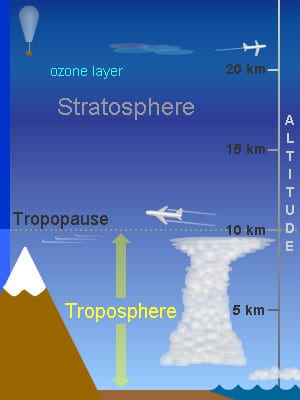A new study by a team of international scientists suggests that climate change is causing a significant impact on the structure of the Earth’s atmosphere. The study considered decades of weather balloon observations and specialized satellite measurements.
Based on these observations and measurements, scientists determined how much the top of the lowest level of the atmosphere is rising. They found that the tropopause region is pushing up the boundary with the Stratosphere by about 50-60 meters (about 165-195 feet) per decade.
What’s causing this change?
According to scientists, this rising is caused by warming temperatures near Earth’s surface, causing the lower atmosphere to expand.
Bill Randel, a scientist at the National Center for Atmospheric Research (NCAR), said, “This is an unambiguous sign of changing atmospheric structure. These results provide independent confirmation, in addition to all the other evidence of climate change, that greenhouse gases are altering our atmosphere.”
The tropopause is the upper limit of the troposphere and therefore constitutes the boundary between it and the Stratosphere. Depending on the season, it ranges from about 5 miles above Earth’s surface at the poles to 10 miles at the equator.
The location of the tropopause is of interest to flight crew because it indicates the altitude at which temperature becomes constant with increasing altitude, which is an essential factor in performance and fuel calculations. It also indicates the location of jet streams and the high winds and turbulence associated with them.

However, this increasing height of tropopause in recent decades doesn’t have a significant impact on society or ecosystems. But, it indeed indicates the wide-ranging impacts of greenhouse gas emissions.
By considering the newly available data, scientists analyzed how much tropopause is continuing to rise now that stratospheric temperatures are no longer having a significant impact.
They turned primarily to two sources of information. One was a recently updated archive of observations from radiosondes, which have been lofted high into the atmosphere for decades on weather balloons to measure atmospheric properties. Because the radiosonde data is most detailed over land areas of the Northern Hemisphere between 20 and 80 degrees in latitude, the new study focused on the rising height of the tropopause in that region.
The scientists also analyzed observations from specialized satellite instruments dating back to 2002 that probe the atmosphere by measuring the degree to which Global Positioning System (GPS) radio signals bend and slow as they pass through the atmosphere. This innovative technique, known as GPS radio occultation, was pioneered in part by an array of satellites known as COSMIC (now COSMIC-2), whose data is processed and disseminated by the University Corporation for Atmospheric Research, which manages NCAR.
Using statistical techniques, scientists determined the impact of natural events that temporarily change atmospheric temperatures and affect the tropopause, such as volcanic eruptions and the periodic warming of surface waters in the eastern tropical Pacific Ocean known as El Niño. Doing so allowed them to isolate the role of human-induced warming.
Their observations showed that the tropopause has increased in height at a steady pace since 1980: about 58-59 meters per decade.
Randel said, “The study captures two important ways that humans are changing the atmosphere. The height of the tropopause is being increasingly affected by emissions of greenhouse gases even as society has successfully stabilized conditions in the Stratosphere by restricting ozone-destroying chemicals.”
Journal Reference:
- LINGYUN MENG et al. Continuous rise of the tropopause in the Northern Hemisphere over 1980–2020. DOI: 10.1126/sciadv.abi8065
